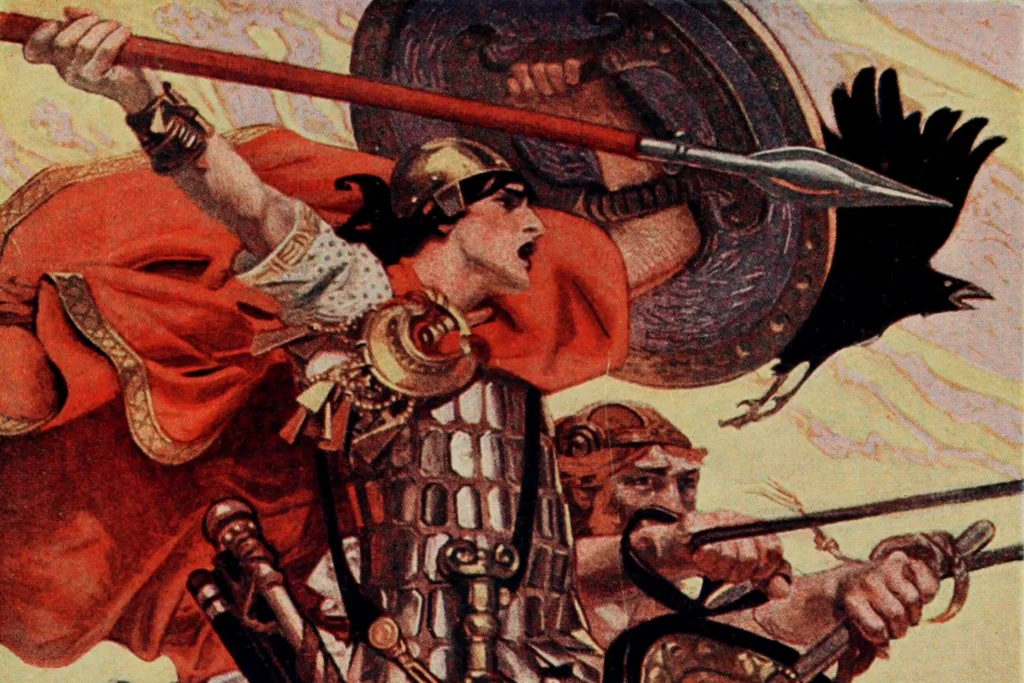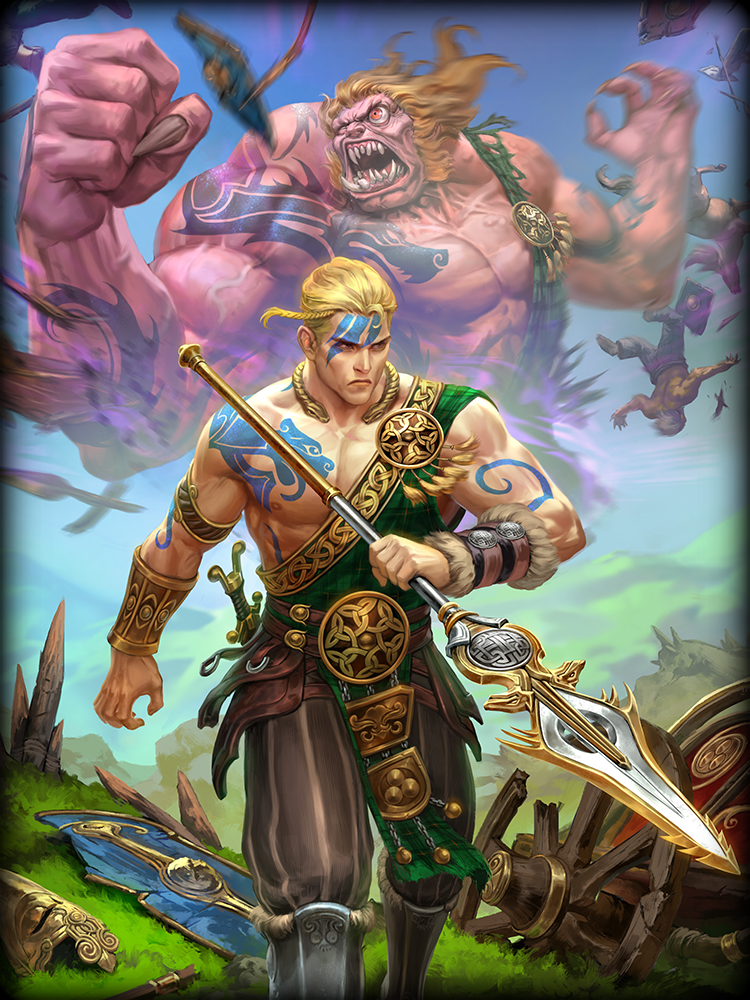In Irish mythology, Cú Chulainn is known as the Child of Light. He is a legendary hero who is revered for his incredible strength and bravery. According to folklore, Cú Chulainn was born as Setanta, the son of the god Lugh and a mortal woman named Deichtine. He was raised by his uncle, King Conchobar of Ulster.
Cú Chulainn’s abilities as a warrior were apparent at a young age. When he was only sevn years old, he defeated the fierce hound of Culann, a blacksmith who lived near King Conchobar’s palace. As a result of this feat, he was given the name Cú Chulainn, which means “hound of Culann.”
Cú Chulainn’s most famous battle took place during the Táin Bó Cúailnge or the Cattle Raid of Cooley. This epic battle was fought between the armies of Ulster and Connacht over a prized bull. Cú Chulainn, who was the champion of Ulster, fought against the armies of Connacht single-handedly. Despite being greatly outnumbered, he was able to hold off the enemy forces for several days.
Cú Chulainn’s incredible strength and skill as a warrior made him a beloved figure in Irish mythology. He is often depicted as a fierce and powerful warrior, with a ferocious battle cry that could strike fear into the hearts of his enemies. His battle prowess was matched only by his loyalty and devotion to his homeland of Ulster.
Cú Chulainn’s story has inspired countless works of literature and art throughout the centuries. His legend has been told and retold in poems, songs, and even comic books. His name has become synonymous with bravery and strength, and he remains one of the most beloved figures in Irish mythology.
Cú Chulainn is a towering figure in Irish mythology. His incredible strength and bravery have made him a beloved hero for generations. His story serves as a reminder of the power of courage and loyalty, and his legacy continues to inspire people around the world today.
The Reality of Cú Chulainn
The existence of Cú Chulainn, the legendary Irish hero, has been a topic of debate among scholars and historians for many years. While some believe that he was a real person who lived sometime around 200BC, others argue that he is purely a mythical figure.
There are several sources that mention Cú Chulainn, including the Ulster Cycle of Irish mythology and the Táin Bó Cúailnge (the Cattle Raid of Cooley), an epic tale that is considered one of the greatest works of early Irish literature. These sources describe Cú Chulainn as a warrior with superhuman strength and agility, who was able to perform incredible feats of bravery and valor.
Despite the popularity of thee stories, there is little concrete evidence to suggest that Cú Chulainn was a real historical figure. Many historians believe that his legend was likely based on a combination of real-life figures and mythical elements, and that over time his story became more exaggerated and fantastical.
In any case, Cú Chulainn remains a beloved figure in Irish folklore and mythology, and his legacy continues to inspire people around the world. Whether he was a real person or simply a creation of legend, there is no denying the impact that Cú Chulainn has had on Irish culture and history.

The Greatest Irish Warrior in History
The title of the greatest Irish warrior is a highly debated topic among historians and mythologists. However, there are a few names that stand out in Irish mythology as the most famous and skilled warriors.
One of these warriors is Cú Chulainn, who is said to have possessed superhuman strength and was a skilled fighter from a young age. He is most known for his involvement in the Táin Bó Cúailnge, also known as The Cattle Raid of Cooley, where he defended Ulster aginst the invading army of Queen Maeve of Connacht. Cú Chulainn’s feats in battle, including his ability to enter a “battle frenzy” or ríastrad, have made him a legendary figure in Irish mythology.
Another famous warrior from Irish mythology is Fionn mac Cumhaill, also known as Finn McCool. Fionn was the leader of the Fianna, a group of warriors in Irish mythology who were known for their bravery and skill in battle. Fionn was known for his wisdom as well as his fighting abilities, and is often depicted as a hero and protector of Ireland.
While it is difficult to determine who was the greatest Irish warrior, Cú Chulainn and Fionn mac Cumhaill are certainly two of the most famous and revered figures in Irish mythology. Their stories have been passed down through generations and continue to inspire and captivate people today.
Was Cú Chulainn a Deity?
Cú Chulainn is considered to be a demigod in Irish mythology, rather than a fully-fledged god. According to legend, he is the son of the god Lugh and a mortal woman named Deichtine. As a demigod, Cú Chulainn possessed superhuman strength and abilities, but was not considered to be on the same level as the gods themselves.
In the Ulster Cycle of Irish mythology, Cú Chulainn is primarily knon as a warrior hero who defends Ulster from invaders and enemies. He is famous for his incredible feats of strength and bravery, as well as his fierce loyalty to his people.
Despite his status as a demigod rather than a god, Cú Chulainn is still revered in Irish folklore and is a popular figure in modern culture. His story has been retold in countless books, movies, and television shows, cementing his place as one of the most iconic characters in Irish mythology.
The Most Famous Irish Myth
The Irish mythology is rich with numerous myths and legends that have been passed down through generations. However, one of the most famous Irish myths is the story of the great hero Fionn mac Cumhaill, also known as Finn McCool.
Fionn mac Cumhaill is a legendary warrior and leader of the Fianna, a group of elite warriors in ancient Ireland. According to the myth, Fionn was born with a supernatural ability that allowed him to gain knowledge and wisdom from eating the flesh of a magical salmon. He also possessed incredible strength and was known for his bravery in battle.
One of the most popular stories assoiated with Fionn is the legend of the Giant’s Causeway. According to the myth, Fionn built a causeway made of stones across the sea to Scotland to confront a giant named Benandonner. When Benandonner crossed the causeway to Ireland, Fionn disguised himself as a baby and his wife as a nursemaid. When Benandonner saw the size of the “baby,” he fled back to Scotland, destroying the causeway behind him.
Another famous Irish myth is the story of Cú Chulainn, a legendary hero of the Ulster Cycle. According to the myth, Cú Chulainn was a skilled warrior who gained his strength from a magical drink called “the ale of strength.” He was known for his bravery, his ability to transform into a terrifying monster on the battlefield, and his tragic death at a young age.
The Tuatha Dé Danann, a group of mythical beings associated with pre-Christian Ireland, also feature prominently in Irish mythology. They were believed to be a race of gods and goddesses who possessed magical powers and ruled over Ireland before the arrival of humans. The stories of the Tuatha Dé Danann often involve battles with other supernatural beings, as well as their interactions with humans.
While there are numerous myths and legends in Irish mythology, the stories of Fionn mac Cumhaill, Cú Chulainn, and the Tuatha Dé Danann are some of the most famous and enduring. These stories continue to capture the imagination of people around the world, and are an important part of Ireland’s rich cultural heritage.

Conclusion
Cú Chulainn is undoubtedly one of the most iconic figures in Irish mythology. His story has captured the hearts and imaginations of people for centuries, and his legacy lives on to this day. As the Hound of Ulster, Cú Chulainn was a fierce warrior hero and demigod, believed to be an incarnation of the Irish god Lugh. His feats of strength and bravery continue to inspire awe and admiration, and his story remains an integral part of Irish culture and heritage. Whether he truy existed or not, the tale of Cú Chulainn is a testament to the enduring power of myth and legend, and a reminder of the rich and fascinating history of Ireland.
